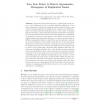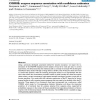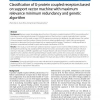24 search results - page 4 / 5 » GASP: Gapped Ancestral Sequence Prediction for proteins |
BMCBI
2011
12 years 9 months ago
2011
Background: Comparison of the human genome with other primates offers the opportunity to detect evolutionary events that created the diverse phenotypes among the primate species. ...
RECOMB
2005
Springer
14 years 5 months ago
2005
Springer
Abstract. Asymmetric functional divergence of paralogues is a key aspect of the traditional model of evolution following duplication. If one gene continues to perform the ancestral...
BMCBI
2007
13 years 5 months ago
2007
Using a previously developed automated method for enzyme annotation, we report the reannotation of the ENZYME database and the analysis of local error rates per class. In control ...
BMCBI
2004
13 years 5 months ago
2004
Background: Hidden Markov Models (HMMs) have proven very useful in computational biology for such applications as sequence pattern matching, gene-finding, and structure prediction...
BMCBI
2010
13 years 5 months ago
2010
Background: Because a priori knowledge about function of G protein-coupled receptors (GPCRs) can provide useful information to pharmaceutical research, the determination of their ...



